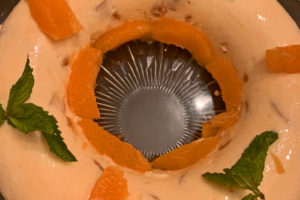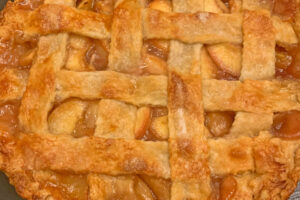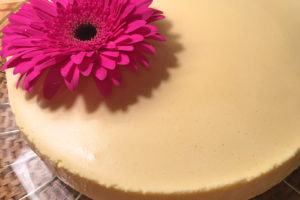One of my most favorite and most elaborate desserts is a Pear Charlotte with Warm Chocolate Sauce. The recipe is based on one that I discovered in a wonderful cookbook called Mastering the Art of French Pastry. I found, however, after making this dessert that it required several alterations. Most serious, is that the original recipe uses far too much cream for the amount of pear purée, resulting in a lackluster flavor. Pears are very subtle in flavor, so I increased the pear purée and decreased the amount of whipped cream. Then I altered many of the cooking techniques.
This is a very time-consuming dessert, but it is quite manageable because much of it can be made well in advance of serving.
The first step is to choose the finest pears. My preference is for comice pears that have some redness in the skin, but because these are often difficult to find, you can use any variety.

Comice pears.
Choose unblemished pears that are neither too green or so ripe they are already beginning to get mushy. I bought pears that were slightly green, but which I allowed to ripen for several days before preparing. You will need between 5-7 pears, depending on their size.
To Poach and Purée the Pears
Dissolve 3 cups of sugar in one quart of cold water. Split a vanilla bean, juice a Meyer or regular lemon, and add them to the water/sugar mixture. (I like the Meyer lemon, a cross between a lemon and a mandarin, because it gives the syrup a more complex flavor.) Bring the mixture to a boil.
Carefully peel the pears with a vegetable peeler.

Carefully peel the pears.
Submerge each one as you peel it into ice water to keep it from browning.

Keep peeled pears in ice water.
Once all the pears are peeled, remove them from the ice water one at a time, cut them in half, discarding the stem and the core. Rub each pear half with the squeezed lemon, again to prevent coloring.
Add the pears to the boiling syrup and place a lid from a smaller pot on top to keep the pears submerged.

Poach the pear halves.
Lower the heat, keeping the liquid at a simmer. Cook until the pears are no longer hard and can be easily pierced, generally 3-8 minutes depending on the ripeness of the pears. Do not let them get mushy. Remove from the heat and let them cool in the syrup. Maintain the lid on top because if they are not submerged they will turn brown. Reserve the pear-poaching liquid.
Purée all but 1 or 2 of the poached pears in a food processor with 2 tablespoons of sugar, plus 2 extra tablespoons of Meyer lemon or regular lemon juice.

Purée the pears.
Strain the mixture through a fine sieve, and stir in 2-3 tablespoons of pear liqueur.

Strain the purée.
The best liqueur for a Pear Charlotte is Pear William, which is an eau de vie de poire. Unfortunately, I was unable to locate any Pear William, so I settled for this liqueur, which is pictured below and was more than adequate.

Pear liqueur.
This can be done several days ahead of making the dessert. Just cover tightly and refrigerate.
To Make the Lady Fingers and Biscuit Layers
Brush two large, heavy baking sheets with melted butter, and lightly dust them with flour. Shake the sheets around to be sure the flour adheres evenly to the butter, then tap the sheets to remove any excess flour.
Take the ring of an 8-inch springform and place it on one corner of one of the prepared sheets, marking a circle in the flour. In the other corner of the same pan, mark a slightly smaller circle with the bottom of the springform.

Mark circles on the baking sheet.
Measure the height of the ring of your springform pan. Then with a ruler and the tip of a knife draw two strips the same height as the springform ring on the second baking sheet.
Place one oven rack at the middle level and another at a higher level. Preheat the oven to 350°.
Separate the eggs in two different bowls. Beat the egg yolks until well combined, then gradually beat in 1⁄2 cup of the superfine sugar. If you can’t find superfine sugar, just run regular granulated sugar in a food processor for a minute or so.

Beat egg yolks and sugar.
Beat in the vanilla. Continue to beat until the mixture is very thick and creates a slowly dissolving ribbon when you lift the beater.

Beat to form a ribbon.
Beat the egg whites in the other bowl until frothy, then beat in the cream of tartar. Continue beating while gradually adding the remaining 1⁄4 cup of the sugar. Continue whipping until the egg whites form very stiff peaks.

Beat the egg whites.
Fold 1⁄3 of the beaten egg whites into the yolk mixture with a rubber spatula. Place 1⁄3 of the flour in a sieve and sift it into the batter, folding it in carefully. Fold in the remaining 2⁄3 egg whites and flour, alternately by thirds.

Fold in flour and egg whites.
Scoop the batter into a large pastry bag fitted with an approximately 5⁄8-inch plain pastry tube. I like to use a vinyl pastry bag because it washes out more easily than a canvas bag.
First pipe the decorative disc into the larger circle. Starting at the perimeter of the circle, pipe tear-dropped shapes, ending at the the center of the circle. Continue piping teardrops until you have covered the entire circle. Finish by piping a 1-inch circular dome over the teardrops at the center of the circle.
Then pipe in the smaller circle a biscuit which will line the bottom of your charlotte mold. Start at the center of the circle, piping a continuous spiral, completely filling the circle. Because this biscuit will be at the bottom, you don’t have to worry about appearance.
Sift confectioner’s sugar over both biscuits until the batter is white. Place on the center rack of the oven. Splash some cold water on the bottom of the oven, which produces steam, giving the biscuits a pearly finish. Bake about 15-20 minutes, until lightly browned and firm on the outside, but still soft inside.
While the first sheet is baking, pipe two strips of lady fingers about 1-inch wide to match the height that you have drawn in the flour. By piping them adjacent to each other, you will have an easier time molding them to the sides of your springform. Again sift with confectioner’s sugar. If the first sheet of biscuits is not yet finished baking, place the ladyfingers on the upper level rack. Again splash with water. Check the time that you place this second sheet in the oven.
When the first sheet of biscuits is fully baked remove it from the oven, then move the sheet of ladyfingers to the center rack to finish the baking. When the sheets come out of the oven, immediately run a thin spatula carefully under the biscuits and the ladyfingers to loosen them, otherwise they will stick to the pan. Remove all to a rack to cool completely.

Baked decorative and bottom discs.

Baked ladyfinger strips.
These cakes may be made 2-3 days ahead of assembling the dessert. Simply store them carefully in plastic bags or in airtight cookie tins. They may also be frozen in plastic bags for up to 1 month. If frozen, defrost them overnight in the refrigerator before use.
For the Syrup
Combine the sugar and water in a saucepan and bring to a boil, stirring occasionally.

Boil the sugar syrup.
Let the syrup cool, then store in an airtight jar, where it will keep for several months. If it crystallizes, add a little water, bring to a boil, and let it cool.
To Make the Mousse
Chill a large bowl and a beater. Combine 1⁄3 of the pear purée with the gelatin in a small saucepan, stirring constantly until the gelatin is fully dissolved.

Dissolve gelatin in pear purée.
Pour into a large bowl.
Stir the remaining pear purée into gelatin-purée mixture, stirring occasionally until it cools.
Meanwhile, whip the cream to soft peaks. Place the gelatin-purée mixture in ice water, and stir just until it begins to thicken. Do not let it set.

Cool the pear purée.
Fold in the whipped cream.

Fold in the whipped cream.
You must then begin assembling immediately.
To Assemble the Pear Charlotte
Place just the ring, not the bottom, of your springform in the center of a serving plate.
Combine 3 tablespoons of the syrup with 3 tablespoons of the pear poaching liquid, and 1-2 tablespoons of pear liqueur. Cut the remaining pear halves into slices, and set aside.
Trim both sides of the ladyfinger strips to match the height of the ring.

Trim the ladyfinger strips.
Brush the backs of the strips with the above liquid.

Brush syrup on ladyfingers.
Line the sides of the mold with as much ladyfinger length as you need. Trim the smaller of the biscuits to fit exactly inside the lady fingers, place in the ring upside down, and brush the back of it with the above liquid.

Line the mold.
I made the bottom biscuit a bit too small here and had to fill in the edges with cuttings from the ladyfingers.
Note: These steps should be prepared before you make the mousse.
Then fill the mold with half of the pear mousse. Place the sliced pears over the mousse in the ring.

Fill mold with mousse and pears.
Fill the mold with the remaining mousse, and smooth over the top. Cover with plastic wrap and refrigerate for several hours or overnight.
To Serve the Pear Charlotte
Carefully remove the outer ring of the springform. Brush the back of the decorative top biscuit with the syrup and poaching liquid.

Brush decorative disc with syrup.
Remove the plastic wrap from the pear charlotte and place the decorative disc on top. Note: I don’t recommend placing this disc on a hard surface, as I have unfortunately done here, because it rubs off some of the outer crust and spoils the appearance. Try just holding it your hand while you brush.

Place decorative disc on top.
Chop the chocolate finely, boil the half cup of water and gradually add it to the chocolate, stirring until melted. Stir in the softened butter. Spoon chocolate sauce onto each serving plate, then place slices of the pear charlotte on top.






